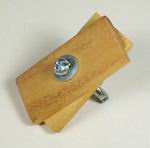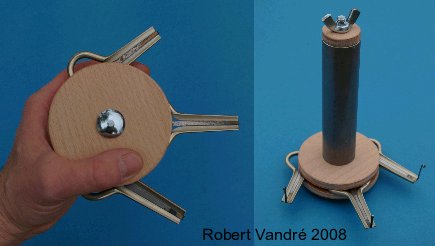back to tones and pitches
to the contents
forward to pieces of music
How to Play
on Several Jew's Harps
|
back to tones and pitches |
to the contents |
forward to pieces of music |
By changing several jew's harps with different fundamental notes while
playing, musical harmonies can be expressed. The harmony of simple
melodies often requires only two or three cords. For example, melodies in
C major are accompanied with the major chords C and G or C, G and F. When
playing on several jew's harps, the fundamental notes play the role of the
chords. E.g., the german nursery rhyme Hänschen Klein can be accompanied
with C and G major. In sound example 18
(247 KB) I play it on two jew's harps tuned in C and G.
How can you hold and rapidly change several jew's harps? Usually several
jew's harps are assembled using clips. The jew's harp assemblies and clips
shown in figure 1 can be purchased.
figure 1
| jew's harp assembly with metal clips
by Andreas Schlütter, www.schluetter-trump.de/ |
wooden clip by dan moi, www.danmoi.com |
|
|
 |
| picture: Andreas Schlütter | picture: Dan Moi |
However, I want to suggest other ways of playing several harps, namely 1.
a way of playing without clips or other aid, and 2. an assembly that is
played most easily: The aura with weight.
1. Play several jew's harps without aid
The jew's harp virtuosos Fritz Mayr from Bavaria and Albin Paulus from
Austria hold one or two jew's harps in both hands. The jew's harps are
plucked with a free finger of the respective opposite hand. My first
suggestion follows this principle, without technical aid (figure 2). Both
hands hold one or two jew's harps. The first is held between thumb and the
lowest joint of the index finger. Index finger and ring-finger are
bent, pressing the second jew's harp against the ball of the thumb, so
that the parallel arms of the jew's harp frame protrude between the two
fingers and point away from the palm. The middle-finger remains free and
plucks the jew's harps of the opposite hand (figure 2, red arrows).
figure
2

The above sound
exapmle 18 (247 KB) has been played with two jew's harps
held between thumbs and index fingers (figure 2, positions 1 and 2).
Disadvantage of this technique:
This way of holding several harps in both hands feels unfamiliar in the
beginning and needs some practice.
Advantage: After some practice
this way of playing works very well. No screwing and assembling is needed.
The jew's harps remain free and can be used separately or in changing
combinations without dismantling.
2. Assembly as an aura with weight
In the year 1816 the german jew's harp enthusiast Heinrich Scheibler
presented an assembly of up to five harps called aura
(according to Regina Plate
1992). The aura consists of two wooden discs with a screw in the
center. The jew's harps are clamped between the discs. I take a longer
screw and put it through an additional section of metal tubing (figure 3,
ca. 20 cm long and with a weight of about 200 g). Thus, the assembly is
functioning as a balance weight and the jew's harps sound with contact to
the lips only, without contact to the teeth (see play
without contact to the teeth). Like Heinrich Scheibler, I line
the inner side of the discs with thin leather to prevent vibrations and
rasping sounds. I do not fix the jew's harps radially but angled, because
I hold the aura at the discs, not at the tube (figure 3 left). Thus, the
pivot is not the screw but the wrist.
figure
3

For sound
example 19 (321 KB) three jew's harps are assembled, tuned
A1, D and E.
Disadvantage of this technique:
The assembly has a somewhat elevated weight.
Advantage: The additional weight
pays off. The quick changing between the jew's harp is much easier if it
is enough to put them on the lips. No exact adjusting to the teeth is
required. When playing for some time, the weight spares the teeth,
making the playing very comfortable.
Finally a small piece of music, played on three jew's harps: Bougie, sound example 20 (1067 KB).
 Write
down jew's harp music? The first part of sound example 20, "Bougie", in
music notation (29 KB)
Write
down jew's harp music? The first part of sound example 20, "Bougie", in
music notation (29 KB)
| to the top | ||
|
back to tones and pitches |
to the contents |
forward to pieces of music |